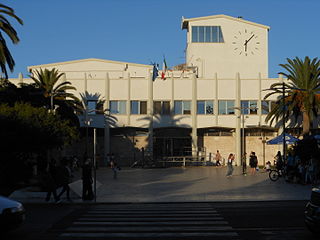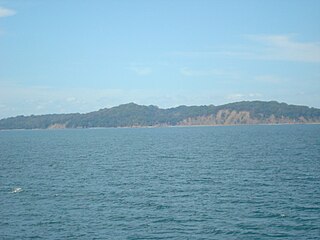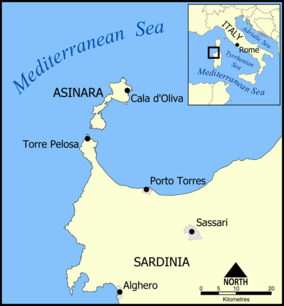
Porto Torres is a comune and a city of the Province of Sassari in north-west of Sardinia, Italy. Founded during the 1st century BC as Colonia Iulia Turris Libisonis, it was the first Roman colony of the entire island. It is situated on the coast at about 25 kilometres (16 mi) east of Capo del Falcone and in the center of the Gulf of Asinara. The port of Porto Torres is the second biggest seaport of the island, followed by the port of Olbia. The town is very close to the main city of Sassari, where the local university takes office.

Alcatraz Island is a small island in San Francisco Bay, 1.25 miles (2.01 km) offshore from San Francisco, California, United States. The island was developed in the mid-19th century with facilities for a lighthouse, a military fortification, and a military prison. In 1934, the island was converted into a federal prison, Alcatraz Federal Penitentiary. The strong currents around the island and cold water temperatures made escape nearly impossible, and the prison became one of the most notorious in American history. The prison closed in 1963, and the island is now a major tourist attraction.

Pianosa is an island in the Tuscan Archipelago in the Tyrrhenian Sea, Italy. It is about 10.25 km2 (3.96 sq mi) in area, with a coastal perimeter of 26 km (16 mi).

The province of Sassari is a province in the autonomous island region of Sardinia in Italy. Its capital is the city of Sassari. As of 2017, the province had a population of 493,357 inhabitants.

Asinara is an Italian island of 52 km2 (20 sq mi) in area. The name is Italian for "donkey-inhabited", but it is thought to derive from the Latin "sinuaria", and meaning sinus-shaped. The island is virtually uninhabited. The census of population of 2001 lists one man. The island is located off the north-western tip of Sardinia, and is mountainous in geography with steep, rocky coasts. Because fresh water is scarce, trees are sparse and low scrub is the predominant vegetation. Part of the national parks system of Italy, the island was recently converted to a wildlife and marine preserve. It is home to a population of wild Albino donkeys from which the island may take its name.
Princess Romanework Haile Selassie, sometimes spelt as Romane Work Haile Selassie, was the eldest child of Emperor Haile Selassie of Ethiopia by his first wife, Woizero Altayech.

Castelsardo is a town and comune in Sardinia, Italy, located in the northwest of the island within the Province of Sassari, at the east end of the Gulf of Asinara.

Sorso is a comune (municipality) of c. 14,700 inhabitants in the province of Sassari in the Italian region Sardinia, located about 8 kilometres (5 mi) north of Sassari.

Stintino is a coastal comune (municipality) in the Province of Sassari in the Italian region Sardinia, located about 200 kilometres (120 mi) north of Cagliari and about 35 kilometres (22 mi) northwest of Sassari.

Il camorrista is a 1986 Italian noir-crime drama directed by Giuseppe Tornatore. His film debut, it is based on the true story of the Italian crime boss Raffaele Cutolo, and adapted from the novel by Giuseppe Marrazzo. The International version is shorter than the original Italian release.
In Italian law, Article 41-bis of the Prison Administration Act, also known as carcere duro, is a provision that allows the Minister of Justice or the Minister of the Interior to suspend certain prison regulations. Currently it is used against people imprisoned for particular crimes: Mafia-type association under 416-bis, drug trafficking, homicide, aggravated robbery and extortion, kidnapping, terrorism, and attempting to subvert the constitutional system. It is suspended only when a prisoner co-operates with the authorities, when a court annuls it, or when a prisoner dies. The Surveillance Court of Rome is the court competent on nationwide level on appeals against the 41-bis decree.

San Lucas Island National Park is an island located off the Pacific shore of Costa Rica in the Gulf of Nicoya. It is part of the Puntarenas district of Puntarenas Canton of the province of Puntarenas.

The Asinara, Italian: Asino dell'Asinara, is a breed of feral donkey indigenous to the island of Asinara, which lies off the north-west coast of Sardinia, Italy, in the province of Sassari. Most of the population is wholly or partly albinistic; the small number of grey donkeys on the island are also considered part of the population, and may be heterozygous carriers of the albino gene. The Asinara is one of the eight autochthonous donkey breeds of limited distribution recognised by the Ministero delle Politiche Agricole Alimentari e Forestali, the Italian ministry of agriculture and forestry. It is called ainu, borricu or molenti in Sardinian.

The Gulf of Asinara is a sea sector included between the Asinara Island, Cape Falcone and the town of Castelsardo, in northern Sardinia, Italy. The communes facing its coast include also Stintino, Porto Torres, Sassari, Sorso, Valledoria and Badesi.
Horst Fantazzini was an Italian-German individualist anarchist who pursued an illegalist lifestyle and practice. He gained media notoriety mainly due to his many bank robberies throughout Italy and other countries. In 1999 the film Ormai è fatta! appeared based on his life

LijSeifu Mikael was an Ethiopian noble, member of the Solomonic dynasty, belonging to the aristocratic Amhara family from Ankober Shewa. He was the grandson of Dejazmatch Mekuria Tesfaye of Menz, a prominent general and a cousin of Emperor Menelik II of Ethiopia. A public figure, educated in Paris at Sorbonne; one of the first few nobles who started paying salaries to their household servants advocating freedom of slaves and an avid supporter of Ras Tafari in his bid to become an emperor of Ethiopia. He served as Ethiopia's minister to France and Germany while he lived in Europe in the 1910s, Ethiopia's Consul General to Eritrea from 1921 to 1925 and Governor of several districts till the eve of the fascist invasion of Ethiopia.

During the Second Italo-Ethiopian War, the Italians captured and either imprisoned as prisoners of war or executed selected prominent Ethiopians. The majority of the public executions and mass incarcerations happened in the wake of the assassination attempt on Rodolfo Graziani. The Italian occupying force gave permission to the black shirts to murder educated Ethiopians, sparing only a few notables who were transported to various concentration camps maintained in the Harar region, Italian Somaliland, Eritrea and Italy. While the majority of prisoners who were kept at Asinara and other camps in Italy survived, tens of thousands of detainees perished under the severe conditions they were forced to live in. According to famous survivors like Ambassador Imru Zeleke, conditions were worse in Italian Somaliland camps due to the scarcity of food, water and medicine. According to Imru Zeleke, tens of thousands of Ethiopians died every year.
Era d'estate is an Italian biographical drama film directed by Fiorella Infascelli, starring Giuseppe Fiorello and Massimo Popolizio, based on the permanence of judges Paolo Borsellino and Giovanni Falcone on the Asinara island.
Duke of Vallombrosa was a title created for the House of Manca. The present holder is disputed.
















